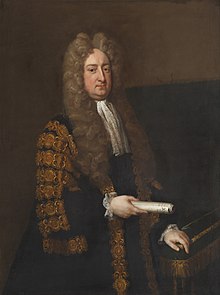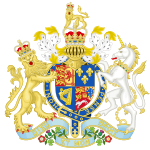| 3rd Parliament of Great Britain | |||||||
|---|---|---|---|---|---|---|---|
| |||||||
 William Bromley, Speaker of the House of Commons | |||||||
| Overview | |||||||
| Term | 27 September 1710 – 8 August 1713 | ||||||
| House of Commons | |||||||
| Members | 558 MPs | ||||||
| Speaker of the House of Commons | William Bromley | ||||||
| House of Lords | |||||||
| Lord Keeper of the Great Seal | Baron Harcourt | ||||||
| Sessions | |||||||
| |||||||
| Parliaments of Great Britain |
|---|
 |
The 3rd Parliament of Great Britain was summoned by Queen Anne on 27 September 1710 and assembled on the 25 November 1710. Under the Triennial Act, the Parliament was due to expire, if not dissolved sooner, at the end of the term of three years from the first meeting. In the event it was actually dissolved on 8 August 1713.
The new House of Commons comprised 346 Tories, 196 Whigs and 14 others, which represented a Tory landslide.[1] This was largely due to anti-Government feelings caused by the trial of Henry Sacheverell for verbally attacking dissenters and a growing anti-war sentiment. William Bromley, Member of Parliament for Oxford University, was installed as Speaker of the House of Commons.
At the start of the second session the terms of a peace deal with France were defeated by the Whigs. Harley created 12 new Peers in the House of Lords, nicknamed "Harley's Dozen", to forestall a similar problem there. Harley then adroitly engineered condemnation of Britain's allies in the peace talks and by the end of the second session had got decisive backing for his policy of acting alone.
Completing the terms of the Treaty of Utrecht delayed the third session until April 1713. When it did reconvene there were open splits in the Tory party on a number of issues. Viscount Bolingbroke, a Secretary of State, took the opportunity to seek the leadership of the Party.
The Parliament was dissolved on 8 August 1713.
- ^ "The 3rd Parliament of Great Britain". History of Parliament Online. Retrieved 8 November 2017.